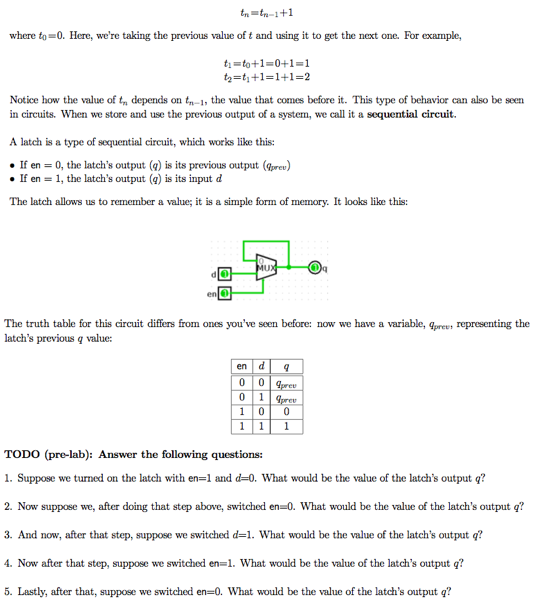Please help asap!

where to=0. Here, we're taking the previous value of t and using it to get the next one. For example, t,-ti +1 = 1+1=2 Notice how the value of tn depends ont1, the value that comes before it. This type of behavior can also be seern in circuits. When we store and use the previous output of a system, we call it a sequential circuit. A latch is a type of sequential circuit, which works like this: If en = 0, the latch's output (g) is its previous output (grev) If en = 1, the latch's output (g) is its input d The latch allows us to remember a value; it is a simple form of memory. It looks like this: en The truth table for this circuit differs from ones you've seen before: now we have a variable, qpree representing the latch's previous q value: PreU TODO (pre-lab): Answer the following questions: 1. Suppose we turned on the latch with en-1 and d-0. What would be the value of the latch's output q? 2. Now suppose we, after doing that step above, switched en-0. What would be the value of the latch's output g? 3. And now, after that step, suppose we switched d-1. What would be the value of the latch's output q? 4. Now after that step, suppose we switched en-1. What would be the value of the latch's output q? 5. Lastly, after that, suppose we switched en-0. What would be the value of the latch's output g? where to=0. Here, we're taking the previous value of t and using it to get the next one. For example, t,-ti +1 = 1+1=2 Notice how the value of tn depends ont1, the value that comes before it. This type of behavior can also be seern in circuits. When we store and use the previous output of a system, we call it a sequential circuit. A latch is a type of sequential circuit, which works like this: If en = 0, the latch's output (g) is its previous output (grev) If en = 1, the latch's output (g) is its input d The latch allows us to remember a value; it is a simple form of memory. It looks like this: en The truth table for this circuit differs from ones you've seen before: now we have a variable, qpree representing the latch's previous q value: PreU TODO (pre-lab): Answer the following questions: 1. Suppose we turned on the latch with en-1 and d-0. What would be the value of the latch's output q? 2. Now suppose we, after doing that step above, switched en-0. What would be the value of the latch's output g? 3. And now, after that step, suppose we switched d-1. What would be the value of the latch's output q? 4. Now after that step, suppose we switched en-1. What would be the value of the latch's output q? 5. Lastly, after that, suppose we switched en-0. What would be the value of the latch's output g







